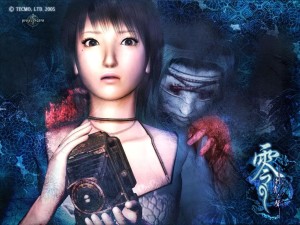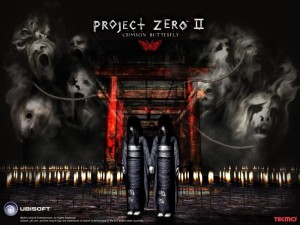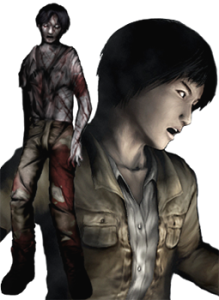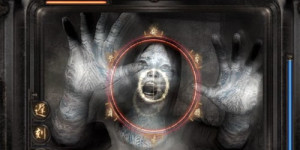Japanese Horror, or J-Horror, is a particular brand of scary entertainment that has had a few flirtatious forays into western spaces. Movie remakes such as One Missed Call, The Gurdge, and the Ring are all examples of the J-Horror style entering the western sphere. Gaming has also had some popular J-Horror experiences reach American shores, and their shared qualities are excellent examples of how the horror genre could undergo a much needed tune-up.
While most big horror video game franchises have come from Japan (such as Silent Hill and Resident Evil) the one that exemplifies the J-Horror style the most is Tecmo’s Fatal Frame franchise, a strange amalgamation of horror, cults, and Pokemon Snap, where the only way to defend yourself is with a paranormal camera.
Fatal Frame (known as Zero in Japan and Project Zero in Europe) was a series that, in the US, was released in the PS2 era, between 2001 and 2005. The general plots of the game regarded young female protagonists becoming trapped in a haunted locale that was the site of a terrible failed ritual. Let’s look at the tenants of J-Horror in the western world via the context of this game.
1. The Other is Scary
The Fatal Frame games are trenched in Japanese culture, moreso than any other major J-Horror release. In this sense, the game is incredibly unfamiliar to those in the west. Shinto texts, strange religious ceremonies, odd architecture — the games play on a different set of expectations than what traditional western gamers are familiar with. In this way, the game has already removed them from their comfort zone and placed them in an unsettling situation they must struggle through.
2. Traditional Strength is Irrelevant
Early on in Fatal Frame II: Crimson Butterfly, you discover the fate of an architectural surveyor, named Masumi, who also ended up in the village. This was a young, able-bodied man, who was in good health and mind. As you discover, he easily succumbs to the supernatural pull of the village and ends up killing his girlfriend who came looking for him. All of the protagonists are young females of lesser frame. It forces the player to rethink what “strength” actually is and try to adapt their usual survival methods to the game.
3. Immersion is Key
A word that gets tossed around a lot when discussing horror experiences is immersion; the more you feel engrossed in the experience, the more effective it is likely to be. Fatal Frame does this brilliantly with the camera combat. While you do have a way to fight back against the spirits, it is not a third-person over the shoulder shoot-em-up. Instead, you must enter a first-person peek through the viewfinder of a camera and look your terrifying foes in the eyes as you line up your shot. J-Horror’s reliance on the supernatural often encourages the use of magical or paranormal defenses, such as paper charms or chanted wards. The Camera Obscura of the Fatal Frame series becomes an integral part of the immersion by forcing the player to become the one looking through the viewfinder.
Thankfully, the future of horror looks bright, and J-Horror is having a resurgence in the western market. After western successes like Slender: The Arrival and the Amnesia franchise, franchises like Fatal Frame are returning to modern consoles. Fatal Frame: Oracle of the Sodden Raven is coming to American WiiUs in late 2015, the first entry in the series in ten years to be released in the west. With its innovative ways of tackling common tenants of horror, we can hope that the Fatal Frame franchise will continue to push the boundaries of horror for years to come.





Ha, sorry. I’m just kinda intense. Don’t take it to heart.
I stand by what I said about J-horror being an unnecessary moniker. That’s more of an aside to what your article was about; I wasn’t saying that culture didn’t play a role in influencing the development of the games. Culture definitely has an influence in the development of the games. What I meant, rather, is that it’s stupid to distinguish the games as two different genres when their only distinguishing characteristic (at this point) settings and props. Why even make the distinction if people across cultures find the games scary. It’s like you’re saying a game that had American influences is “scary,” but a game with Japanese influences is “Japanese Scary.” It’s just kinda dumb. They’re all just horror games, and at this point with more and more games coming out that are American made that have “j-horror” influences, the two genres are losing the distinctions you’ve argued exist. You said it yourself, “Outlast and Amnesia, are modern games that use gameplay tenants often exclusive to Japanese produced games.” That means they aren’t exclusive to Japanese produced games anymore. In any case I digress.
More to the point of what your article was about. My argument was more along the lines of saying that western horror games have already started undergoing a change in tone, and that it isn’t necessarily something new. I think some of those “j-horror” themes started appearing a little bit in games as early as 2007 with big titles like S.T.A.L.K.E.R., and Bioshock, but appeared in more distilled forms in indie games like Penumbra. Since then, those indie games have become even more distilled with the release of Amnesia: The Dark Descent on PC, which I’m sure you know came out almost 5 years ago, and more recently Outlast on PC, and then later on PS4 after its positive reception. The two having been developed by Frictional Games (a team of 5.5 people), and Red Barrels (a team of 12 people) respectively; so yes, they are both absolutely indie games (I assume you were implying that they weren’t when you put indie in quotations marks).
The mention I made of “money grab[s]” might have been a bit distracting from my point on sequels. The point I was making was that, although “j-horror” may have had an influence on horror games that are coming out now from western studios, the innovation that came from those franchises initially isn’t actually happening all that much in them anymore (excluding maybe silent hill’s recent P.T. demo). The franchises have become stagnant with regard to innovation; that’s just inherent in being a franchise, and it’s only emphasized by the fact that they have such a laughable number of sequels. That’s why I think the innovation that’s happening now is happening in indie games, the most visible of which are western indie games. In other words, my point with Five Nights at Freddy’s was that, although it’s indeed making a money grab, it is unique enough and was made recently enough to be considered an “innovation.” But for the most part, those innovations started happening a early as 8 years ago, but probably won’t ever hit the popularity levels of games like Deadspace because publishers can just hype a mediocre game enough that people will buy it regardless.
I will argue my point a little further, because I’m not sure I follow some of your arguments. I find it odd that you discredit the idea of culture playing a role, especially in the idea of horror, because culture can play a large role in what people find scary. The state of America in the 1960s was a key element in why Night of the Living Dead, often nowadays considered the movie that put zombie horror on the map, was so popular. The concept of J-Horror is its own individual breed of horror, defined by its cultural influences. Western Horror, in the time frame of the early to mid 2000s, was driven by shock and violence — Condemned: Criminal Origins, ObsCure, and Clive Barker’s Undying were popular western developed horror games from this time, and they focused largely on the concept of combat and triumph over monsters. Meanwhile, some of the most popular games from Japanese developers — Silent Hill, Fatal Frame, and Siren focus on weaker protagonists, strange and fantastic settings, corrupted Shinto or cult activity, and a heavy emphasis on the supernatural. Even Eternal Darkness: Sanity’s Requiem, a game developed by Canadian developer Silicon Knights, was overseen by Shigeru Miyamoto, playing into its themes of insanity and psychological horror. In another case, look at the Silent Hill franchise. As the development moved away from Konami and into the hands of western developers, many perceived a decrease in quality in the modern releases. PT, the teaser for Hideo Kojima’s Silent Hills, was one of the most effective horror experiences in the past year with lasting appeal and effect. That can’t be said for earlier instances in the Silent Hill franchise, such as Silent Hill Homecoming and Silent Hill Downpour.
I also fail to see how the sequel argument comes into play. Fatal Frame is coming up on its fifth installment (fourth American release) in a series that has lasted over fourteen years. These games aren’t coming out very quickly. However, one of the games you mentioned in your indie list, Five Night’s at Freddy’s, has had three installments in less than a year. Does that not also constitute as a money grab? Also, the other games you listed in your “indie” list: Outlast and Amnesia, are modern games that use gameplay tenants often exclusive to Japanese produced games. Siren was one of the first games to emphasize a non-combat horror experience combined with its Sight-jacking mechanic to look through the eyes of enemies. If anything, you’ve just shown how these gameplay aspects have become popular in modern gaming.
As a final point, I think your post was far too incendiary. If you disagree with me, there’s no need to make it sound like you’re exasperated. We can have rational discourse. I’d like to see what else you’d have to say if you can convey it in a calm and rational manner.
Also, Wikipedia has a good compilation of Japanese Horror media that you find find interesting to read through here.
I’ve never been a huge advocate for genres of things that are preceded by the letter J (J-rpgs, j-pop, jpegs), and this case is no different. When the defining characteristic of a genre is the fact that it’s grounded in the culture of another country, it’s time to take a step back and just acknowledge that it’s an unnecessary term. It’s horror.
That bullshit aside, I’m not entirely sure where this praise for “j-horror” is coming from. Quite honestly most movies in the J-horror genre that have been popular have been pretty lame, and in general the offerings that “j-horror” have had in the US haven’t been all that revolutionary. Which isn’t to say that Resident Evil or the others are bad series, just that none of them are all that revolutionary; Fatal Frame included. The only real innovations that are happening in the Horror genre of gaming are coming from the indie scene where games like Outlast, Amnesia, Yume Nikki, and Five Nights at Freddy’s have found success. Yume Nikki less so than the others, but it’s rare that major innovation comes from large studios like those you might find in the 15 versions of Final Fantasy that have been released. Like, come on, seriously? Fatal Frame is right there with it with its own cavalcade of sequels. I have no expectations that Tecmo will be changing the formula of an already successful series. That’d be counter-intuitive to the purpose of making so many sequels: money.